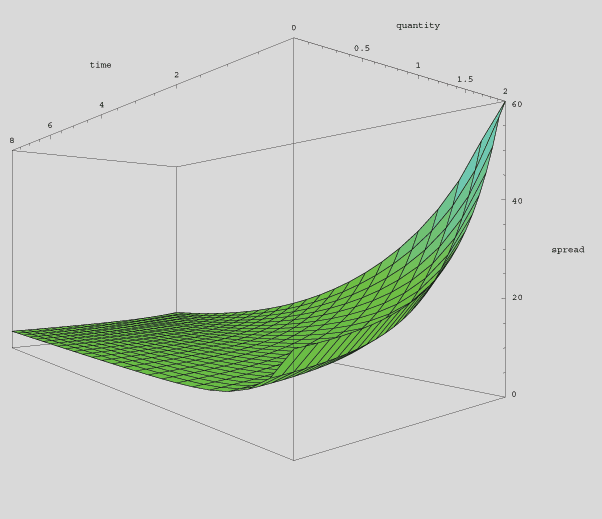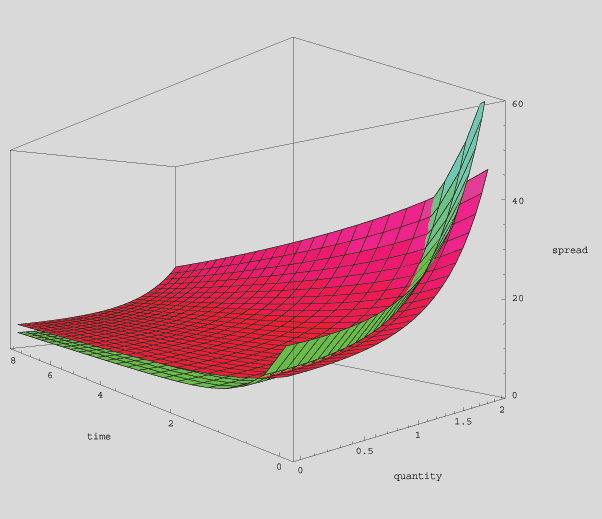Hedge funds and day traders are often claimed to provide liquidity to the markets they participate in. It's clear that these actors do increase market turnover and reduce observable bid-ask spreads. But I contend that their participation may paradoxically increase the spreads paid by longer-term investors, who don't buy and sell on a near instantaneous time-frame, but make portfolio adjustments infrequently and effect those adjustments over a period of time. How is this possible? Shouldn't hedge-fund liquidity reduce trading costs for all participants?
In economics, "supply" and "demand" are defined not by numbers, but by curves. It is incoherent to ask "what is the supply of tennis balls", and expect a number. The number of tennis balls the economy will produce, even in the short run, depends upon their price. We may ask "what is the supply of tennis balls, presuming they can be sold for $1 each?", we'd get one number. If we ask, "what is the supply of tennis balls, if they can be sold for $10 each?", we'd usually get a much larger number. Thus, though we may informally talk about "supply increasing", that's a more complicated idea than most people take it to be. The supply of tennis balls unambiguously increases only if at all prices, the quantity produced would be larger than at some earlier time. But, it is quite possible for a change to occur in an economy, whereby the number of tennis balls that would be produced for $100 increases, while the number that would be produced for $1 decreases. Has "supply" increased or decreased? Neither, exactly.
Similarly, I think that liquidity ought be defined not by any number (like a bid-ask spread, or "price impact" to immediate large trades, or length-of-time required to trade some volume within a constrained spread), but by a surface in a three dimensional space whose dimensions are spread, quantity, and time.
Suppose that we have an asset A, and we wish to define the liquidity of that asset in terms of some currency C. We will define spread as the minimal cost we can achieve buying and selling some quantity (defined in terms of C), within a preset period of time. For example, if I want to know the spread of associated with trading a specific natural gas future in dollars, I'd need to specify how many dollars worth of futures I'll need to trade, and over what period of time I'm permitted to draw out my trades. We'll say $1M dollars, over 3 days. Then I'll ask an "optimal trader" (I know, that's like a unicorn, but this is a thought experiment) to buy and sell $1M dollars worth of futures within a maximum of 3 days, at the end of which her position must be neutral. Our trader controls only the amount and time timing of the roundtrips. She does not control the order in which trades occur, and cannot force a delay between the two legs of the trade, so she cannot speculate on the underlying direction of the market.[1] Our trader is "optimal" in that she adopts the strategy that results in minimum loss, given her quantity requirement and time constraint. The total cost of this game, normalized to a per-dollar basis, defines the spread for natural gas futures as a function of quantity and time.
By reason alone, we know something about the way outcomes of this experiment will vary with different deadlines. As the deadlines get longer, the spread observed can not get larger. If our trader can recycle $1M through gas futures markets at a cost of $10K in 1 day, giving her two days can only help, since she is permitted to terminate early if that's the optimal strategy. So, we are certain that spread as a function of time is strictly non-increasing.
No such mathematical certainty accompanies the relationship between spread and quantity traded. But, although one can contrive unusual cases, as an empirical matter, spread generally increases as a function of the amount that must be traded.
For any asset whose price fluctuates, the spread required by market-makers might vary with time, but should never quite go to zero. Each trade, however distant in the future, represents a sequential purchase and sale, which implies that some other party bears price risk for some interval. Risk-averse market-makers will always require some compensation for bearing risk. Assuming that their level of risk-aversion does not change (including any capacity to hedge), their compensation requirement should increase with their degree of uncertainty about future prices, and the length of time they expect on average to hold positions. The non-zero compensation requirement of the least risk-averse, most certain, lowest-transaction-cost market-makers who ever occasionally transact should define an asymptotic lower bound to spread with increasing time.
Given all this description, we can now draw a qualitative picture of a liquidity:

(The units here are arbitrary.)
Now let's consider what happens to a liquidity surface when a new population of "noise traders" enters the fray. We'll assume they have to following characteristics:
They are frequent traders, as a group always willing to buy and sell at some price.
They are not particularly risk averse. The compensation they require for bearing risk-of-ownership is less than that participants in the market had typically obtained prior to their entry.
They are reasonably efficient transactors. The transaction costs they face are similar to those faced by other active market participants.
Much of their valuation process is "technical" (market price and momentum-based) and game-theoretical rather than "fundamental" (based on analysis of cash-flows achievable from holding the underlying independent of market activity).
How does the entry of this population into a market change the spread achievable on a short time frame, that is when a trader must transact within a short period of time from a randomly chosen moment? Property 1 implies that this population is likely to be active at an arbitrarily chosen moment. Properties 2 and 3 imply that newcomers are likely to be willing to compete with previously existing market-makers, driving down observed instantaneous bid-ask spreads.
But how does this new group affect the spread observed by patient traders, who are in no rush, but wait for the most opportune time to conduct their transactions? There is no certain answer to this question. Recall that as the time horizon goes to infinity, the spread is determined by the lowest-spread market-makers who ever buy or sell, no matter how infrequently. If the new participants, either by accepting less compensation directly or by increasing competitive pressure, reduce the spread required even by the most inexpensive occasional market-makers, then the entry of the new traders will diminish spreads even at long time horizons, implying an unambiguous increase in liquidity.
But suppose that that the previous low-spread market makers achieved their price advantage not by virtue of high risk-tolerance or low transaction costs, but by superior skill at valuing the underlying asset. If the trading habits of the new market participants (see Property 4 above) leads to an increase in unpredictable price volatility, then their entry into the market may diminish those participants' prior ability to predict future prices. In this case, the entry of the new participants will simultaneously reduce spreads at low time horizons, while increasing spreads paid by more patient players. This situation is depicted below. The green surface depicts the liquidity of the market prior to the entry of "noise traders". The red surface shows what happens when "noise traders" enter the market, a simultaneous raising and flattening of the liquidity surface.

Over a short time horizon, the new (red) surface offers lower spreads than the original (green) no-noise-trading surface. (The green "lip" at the front of the graph indicates higher spreads for the original surface than for the red noise-trading surface.) Bid-ask spreads visible in limit order books will generally show lower spreads when noise-traders are present than when they are not. But buyers or sellers willing to spread out moves over a prolonged period will find that the best achievable spreads are worse when noise traders are around than it would have been prior to their entry. Thus, a paradoxical sort of liquidity (or illiquidity) is provided by noise-traders: They reduce costs for traders with short time-horizons who demand quick trades. But they increase trading costs paid by longer-term investors.
Is defining liquidity of an asset as surfaces like this novel? If any readers know of similar definitions, or other approaches to characterizing liquidity (besides mere instantaneous spread or volume measures), please do let me know. I'd thank commenter moldbug; this idea came out of his pushing me to define things in a very thoughtful comment debate.
[1] Our trader says when and how much; a coin is flipped and an order goes either to the buy or sell desk; once the first leg is fulfilled, an order goes immediately to the opposite desk to liquidate the position; the dollar value of the fist leg is added to a total-traded tally; the dollar cost of the round trip is added into the spread.
| Steve Randy Waldman — Monday January 29, 2007 at 5:43am [ 11 comments | 0 Trackbacks ] | permalink |
